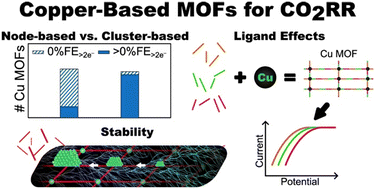Copper-based metal–organic frameworks for CO2 reduction: selectivity trends, design paradigms, and perspectives†
Abstract
Can the carbon budget be balanced? Increasing greenhouse gas emissions and worsening environmental effects demand that humankind find a solution for anthropogenic climate change. As a carbon recycling strategy, the electrochemical carbon dioxide reduction reaction (CO2RR) represents a platform to convert CO2 to valuable chemicals. Despite the discovery that copper uniquely produces hydrocarbons, a lack of suitable catalysts prevents the realization of industrial-scale applications. Recently, metal–organic frameworks (MOFs), extended networks of organic ligands and metal nodes or clusters, have found application as electrocatalysts. Perhaps, this class of materials can be leveraged to tune the properties of copper and yield a suitable CO2RR catalyst. In this review, we present new developments in the application of copper-based MOFs (Cu MOFs) for CO2RR. Firstly, we highlight the potential of CO2RR as a solution for carbon neutrality and proceed by overviewing CO2RR mechanisms and catalysts. We then emphasize the role of copper which leads to our discussion of the trends in Cu MOFs for CO2RR. We conclude by presenting several challenges and perspectives relevant to Cu MOFs in the hope of spurring targeted research in the field.

- This article is part of the themed collection: Catalysis Science & Technology Most Popular 2023 Articles


 Please wait while we load your content...
Please wait while we load your content...